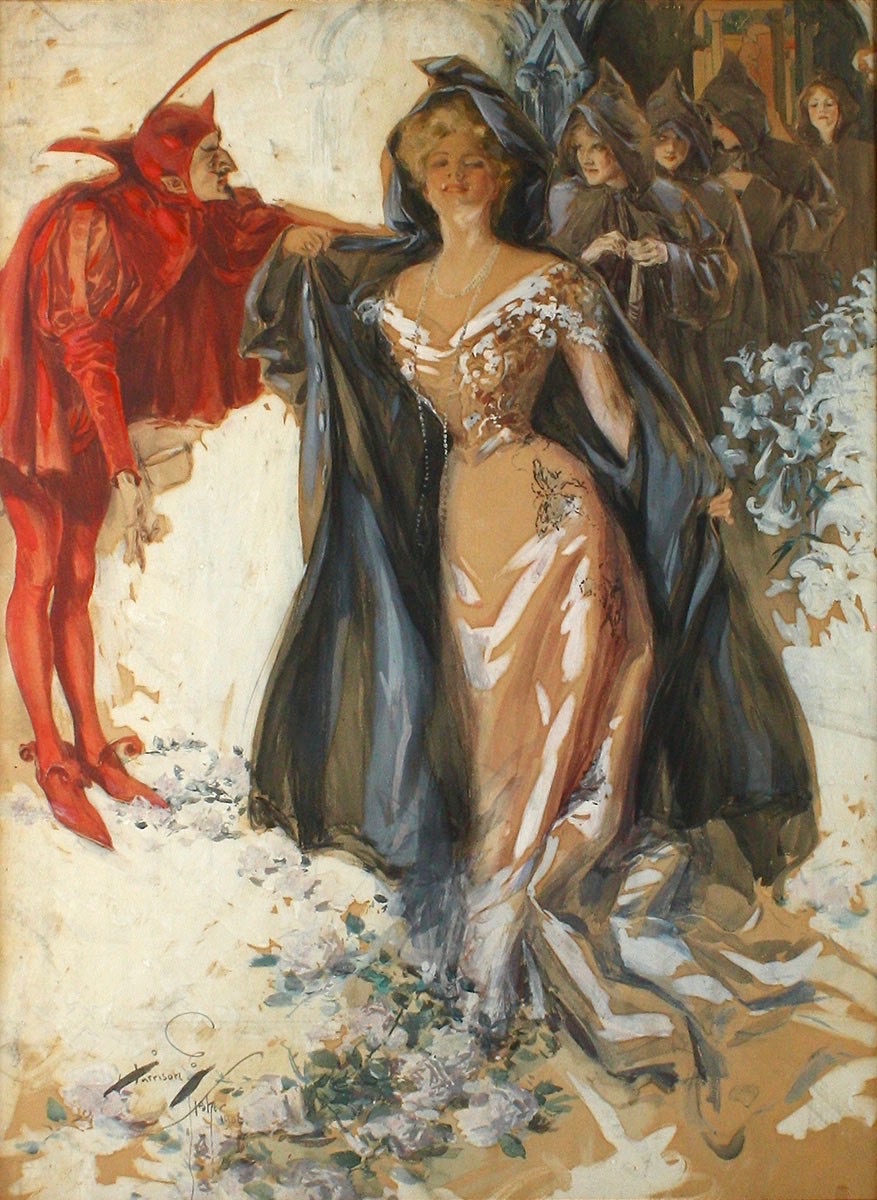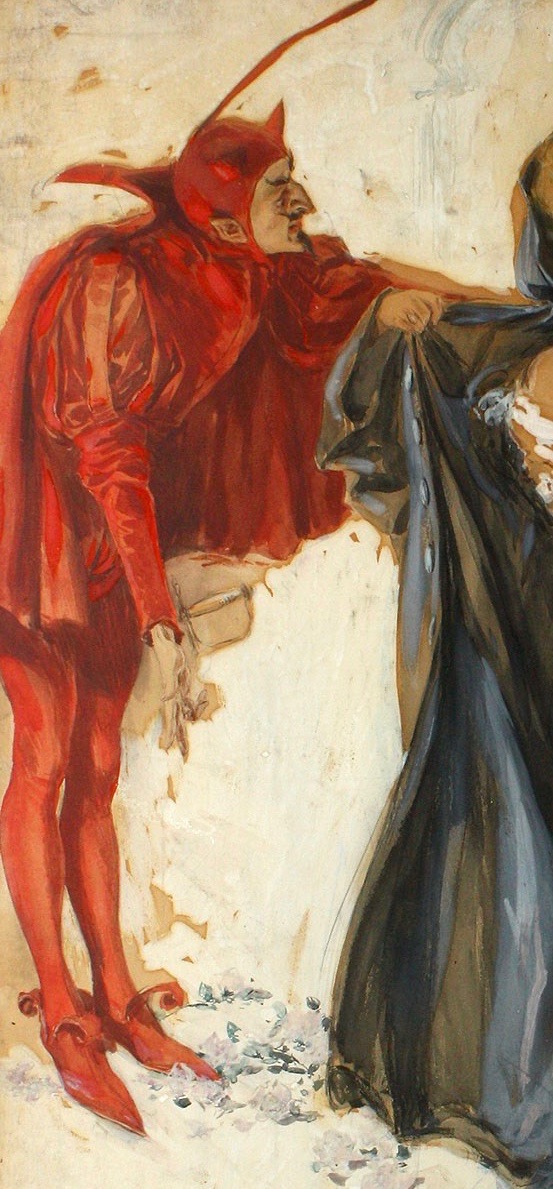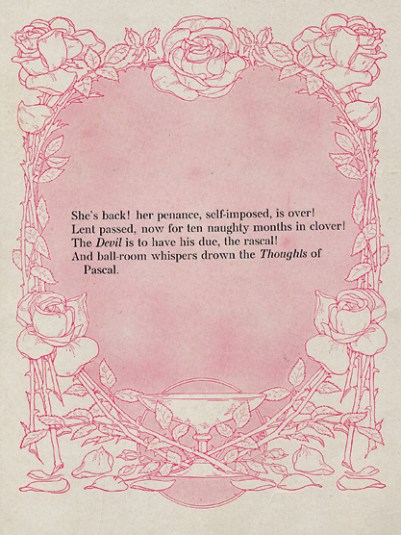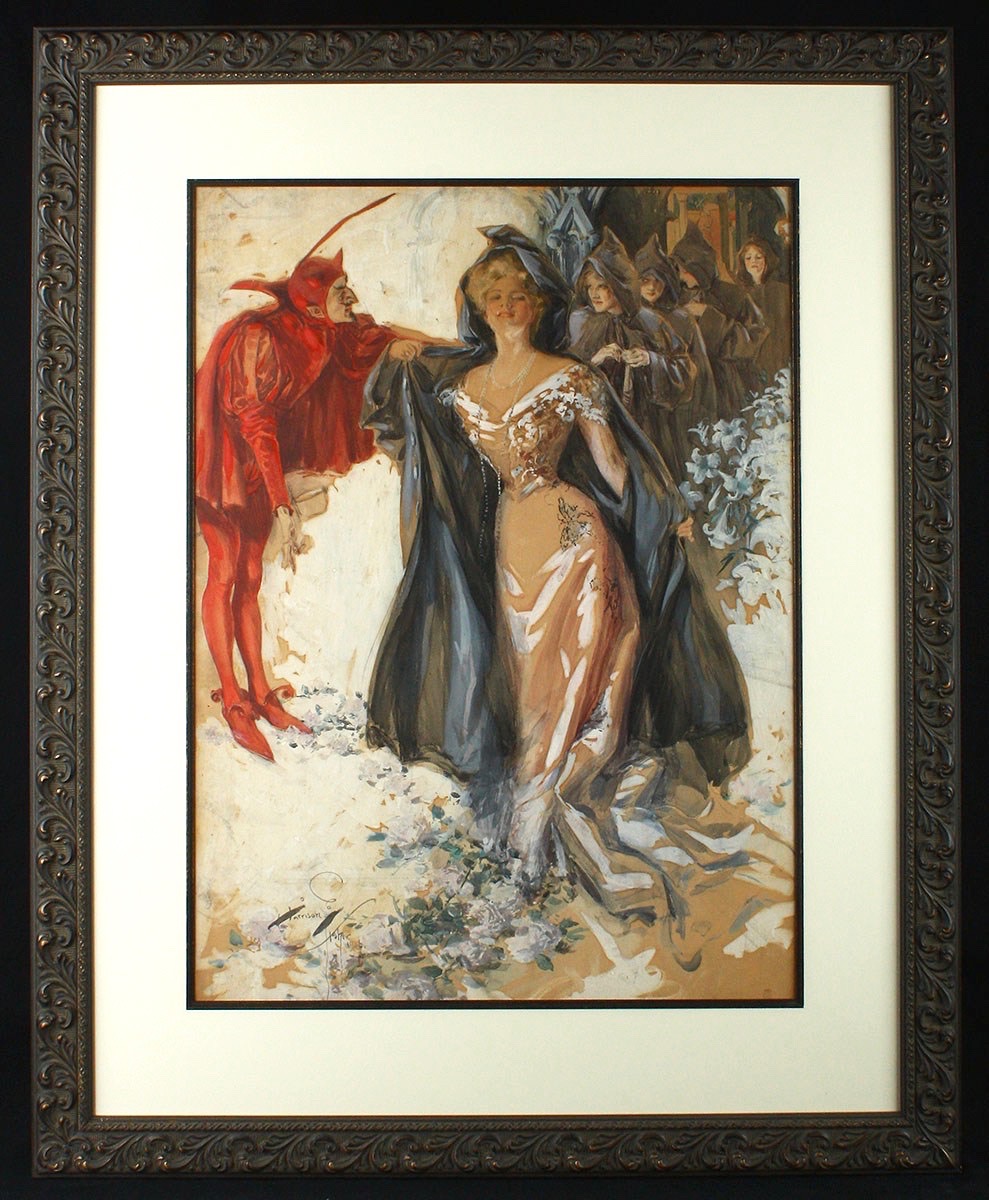Original use: Bookplate for Tennyson's A Dream of Fair Women
Excellent condition
A macabre and dark highly inventive large format gouache illustration painting by Harrison Fisher used as a full color book plate in the 1907 edition of "A Dream of Fair Women" by Lord Alfred Tennyson. In this scene our maiden fair has just completed lent and prepares to give the devil his due and go out ballroom dancing in revealing for the day, corseted attire. This is a classic Harrison Fisher painting and a wonderful and historically impactful example of late Victorian period imagery where traditional customs are seen colliding with a less restrained, more promiscuous Edwardian vision of femininity.
The verse by Lord Alfred Tennyson which this illustrates reads in full "She's back! her penance self imposed is over! Lent passed, now for ten naughty months in clover! The devil is to have his due, the rascal! And ballroom whispers drown the Thoughts of Pascal." This prime example from the Golden Age of Illustration is handsomely matted and framed behind glass and a copy of the book accompanies the sale.
"The Father of a Thousand Girls"
Harrison Fisher was born in Brooklyn, NYC but spent most of his youth in San Francisco until he turned 21 years old. He then moved back to New York where he began his highly successful career as a magazine illustrator.
Harrison Fisher never married, but his "secretary," Kate Clemens, was also his lifetime partner.
During World War One Harrison Fisher showed his patriotism by illustrating posters for the US government, free of charge.
In one newspaper article he was quoted as lamenting that he drew women almost exclusively, but that is what the market demanded.
"The American Girl has found no more facile pencil than that wielded by Mr. Harrison Fisher. He has succeeded in creating a beautiful type distinctly his own."
~ Ladies' Home Journal, 1910
Explore related art collections:
$20,000 - $50,000 / Women as Subjects
See all original artwork by
Harrison Fisher
ABOUT THE ARTIST
Harrison Fisher became nationally known for his illustrations of beautiful women, known as the Harrison Fisher Girls. His illustrations appeared frequently in "Saturday Evening Post", "Scribner's", "Life", and "Cosmopolitan".He was born in Brooklyn, New York, a third generation artist in a family that included his grandfather, Felix Xiver Fisher and his father, Hugo Antoine Fisher. His grandparents emigrated from Austria, an area that is now in Czechoslovakia, with the family name of Fischer. For unknown reasons, the spelling later changed to Fisher after immigration.
The immigrants lived in New York City, and Harrison was born in 1875. When he was nine years old, he moved with his family to Alameda, California and attended public schools. Two years later, in 1889, his mother, age 35, died of Peritonitis. Their father took his two sons Hugo Melville and Harrison, on a lengthy sketching trip along the Pacific coast, and then they settled again in Alameda.
The father instructed his sons in drawing and painting, and they also studied at the Mark Hopkins Institute of Art, formerly the San Francisco Art Association. Amedee Joullin, noted for his paintings of the Aztec Indians, was especially influential on Harrison's work. In 1894, Hugo Anton and his sons opened an art studio at 506 Battery Street in San Francisco, and that same year, one of Harrison's political cartoons titled JAPAN-MADE AMERICA appeared in the humor magazine Judge.
The following year, Harrison began working in the news room as a Staff Artist for the "Morning Call", later the "San Francisco Call". He did drawings of sporting events, society functions and pen and ink illustrations for short stories. He continued to do free-lance work for "Judge" magazine. About a year later, William Randolph Hearst hired him for the "San Francisco Examiner", and then sent him to New York to beef up the "New York Journal", which Hearst had just acquired. Harrison's work was so popular that he accepted an offer from PUCK magazine, a rival of "Judge" and one of the nation's first humor magazines. He also did "Saturday Evening Post" covers and other magazine work, and for some time, there was scarcely a leading publication that did not have his work.
By 1906, he was rehired by Hearst for the American Magazine, renamed The American Weekly. Harrison also illustrated for Hearst publications, the most widely circulated in the country, which made the illustrator very famous. He was a top cover artist for Cosmopolitan and had a studio near their offices.
When he died, a family member who inherited his work, at the artist's request, kept the paintings she wanted and burned the rest including 800 of Harrison's originals.
Walt Reed, "The Illustrator in America"
Edan Hughes, "Artists in California, 1786-1940"
Walt Reed, "The Illustrator in America"
Edan Hughes, "Artists in California, 1786-1940"
Via AskArt







